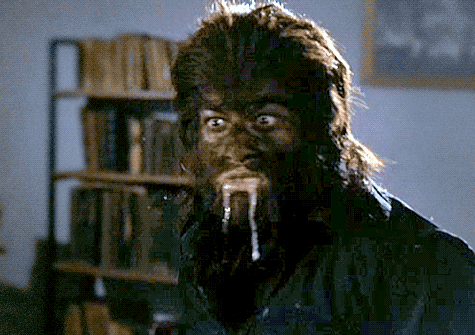Werewolf Fact #72 – Returning to Human Form
Time for Werewolf Fact #72! Wow, that’s a lot. And that’s not counting all the books and articles and ask responses and other things I’ve done over the years. It’s been a fun ride.
But for now, let’s turn our attention to something a patron pointed out I’ve never actually discussed… what makes a werewolf return to human form?

I’ll be honest: popular culture has taken much more of an interest in laying out the details about returning to the human form than did folklore, overall. In folklore, the act of changing to and from was certainly the centerpiece of the horror, but popular culture and its emphasis on werewolf characters led into a deeper evaluation of such an experience. Folklore also generally discussed the transformation into a monster much more than out of it, at least in more laborious and horrific detail (see Lykaon, Niceros, etc).
We see painful transformations to the werewolf form in folklore quite a bit, as I’ve discussed before. In fact, the prime example is one of the earliest surviving recorded werewolf legends. And yet even turning into the bestial form was occasionally painless in folklore, involving donning a magic skin or performing a simple ritual to suddenly become a wolf. As for the werewolf returning to the human form, as far as folklore is concerned, that often seems almost or entirely effortless.
Obviously, in popular culture, it’s much more common to have the dramatic to or from in either form. I’m personally a big fan of this, as you’d know if you’ve read any of my fiction (be sure to check that out at my website!), but if you really want to get down and dirty with werewolves being true to folklore, frankly it is overall common for neither transformation to be painful. And certainly it is even less common for the return to human form to be a particularly traumatic or jarring event. That doesn’t make for a super dramatic story, though, so we see – especially in past werewolf stories, ones that emphasized horror more – the traumatic tos and froms.
With that out of the way, here are some methods of returning to the human form in folklore…
- End of certain timeframe – The most common of triggers to return to the human form, many werewolves will reassume the human form after a certain amount of time has passed. For instance, werewolves in Greek myths like those of Arcadia could return to their human form after seven or ten years, if they hadn’t devoured any human flesh. Likewise, other werewolves would return after a certain number of days or even weeks had passed, with or without other circumstances.
- At will – There are cases of the werewolf returning to human form at will throughout folklore, or else it is unspecified if there are any other required circumstances or acts.
- Removing the magic skin/item – This can vary from being difficult (such as with Sigmund and Sinfjotli) to being as easy as “peeling back the wolf skin,” such as in the tale of the werewolves of Ossory. There are many other examples as well, with varying degrees of difficulty or triggers.
- Using a salve – In some stories, a salve is rubbed on the body to reassume the human form. This is also the case with assuming the wolf form. This is more common in the Renaissance/Early Modern period, overall, often with Satanic werewolf or even witches-rebranded-as-werewolves-by-modern-scholars, though there are a few cases otherwise.
- Putting on your clothes again – In some stories, a werewolf who sheds his clothes turns into the wolf form, and in order to don the human form once more, he must return to his clothing. Sometimes, the clothes turn to stone in the meantime, until he returns to put them back on. Or, such as with Bisclavret, the clothes may be hidden, trapping the werewolf in bestial form.
- Curse removal – In some stories, whoever cursed the werewolf must lift the curse in order to return the werewolf to human form. This is the case in tales wherein the werewolf doesn’t go back and forth at all but is someone cursed to become a wolf and stay that way until said curse is lifted, less like a traditional werewolf.
- Daybreak – Some werewolves returned to the human form at daybreak. While this didn’t appear in stories directly very often, it is mentioned in assorted sourcebooks, such as Baring-Gould and Summers discussing werewolves and how “the desire comes upon them at night.” It can also be speculated based on events in stories, such as Niceros’s Tale, but the circumstances there were never explicitly stated. So this one may be slightly more questionable than the others if you want direct story sources, but I’d say there are plenty of sources around enough to justify it being on this list.
I am not including those funky ones you see all across the internet that weirdos bandy about in their clickbait list articles, like “tossing iron over the werewolf’s head” or whatever, because I need a lot more cross-referenced actual examples of those to include them in a list such as this, as opposed to unfounded Google results that D&D players then like to grab and turn into le silleh memes.
Note that this list, as always, doesn’t cover every single possibility seen in folklore. I’m not even going to pretend I’m trying to do that here. That will be in the future Werewolf Facts book that I’m publishing in a few years (yes, I am working on that).
And that just about covers the general overview! Hope you enjoyed the article.